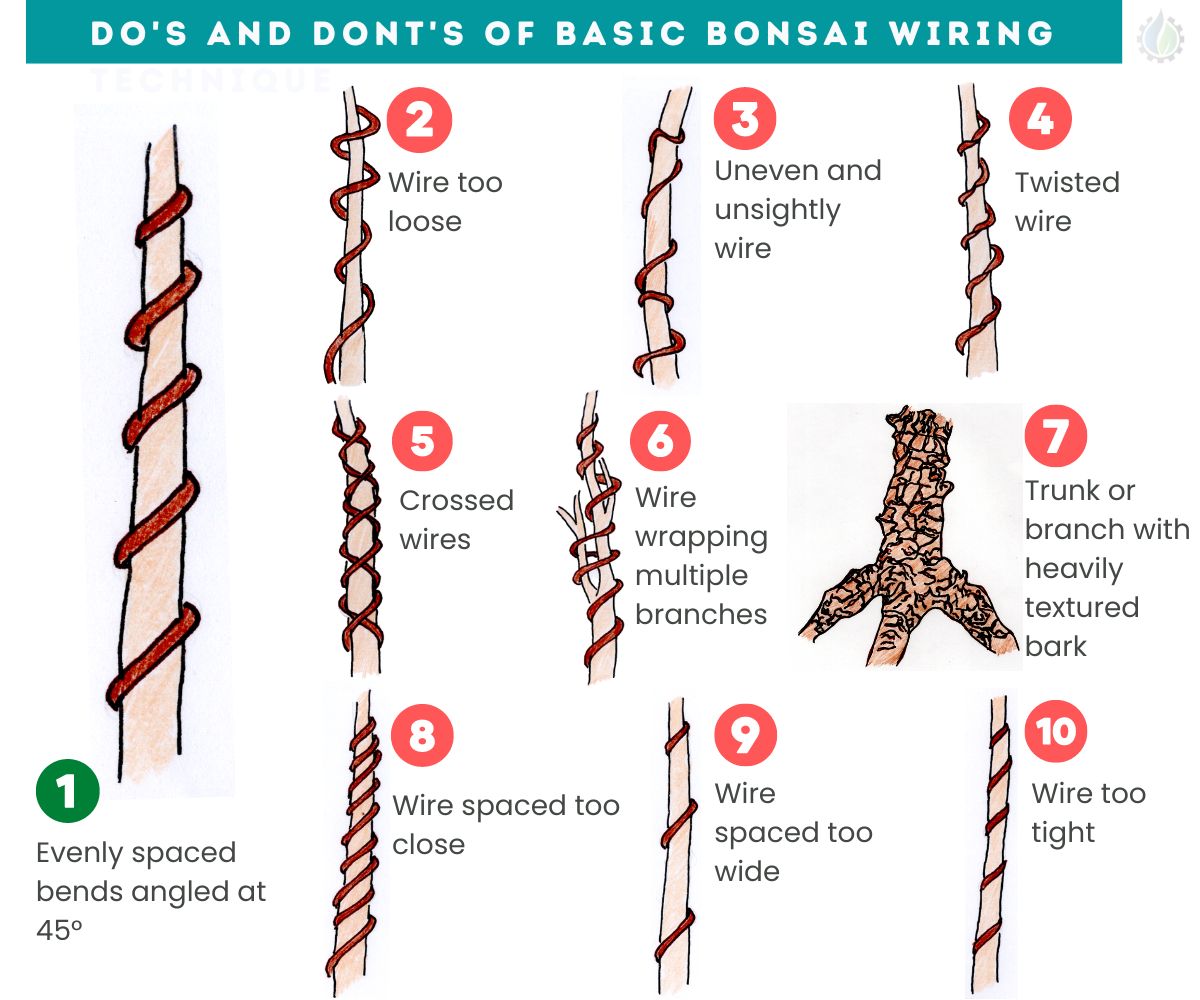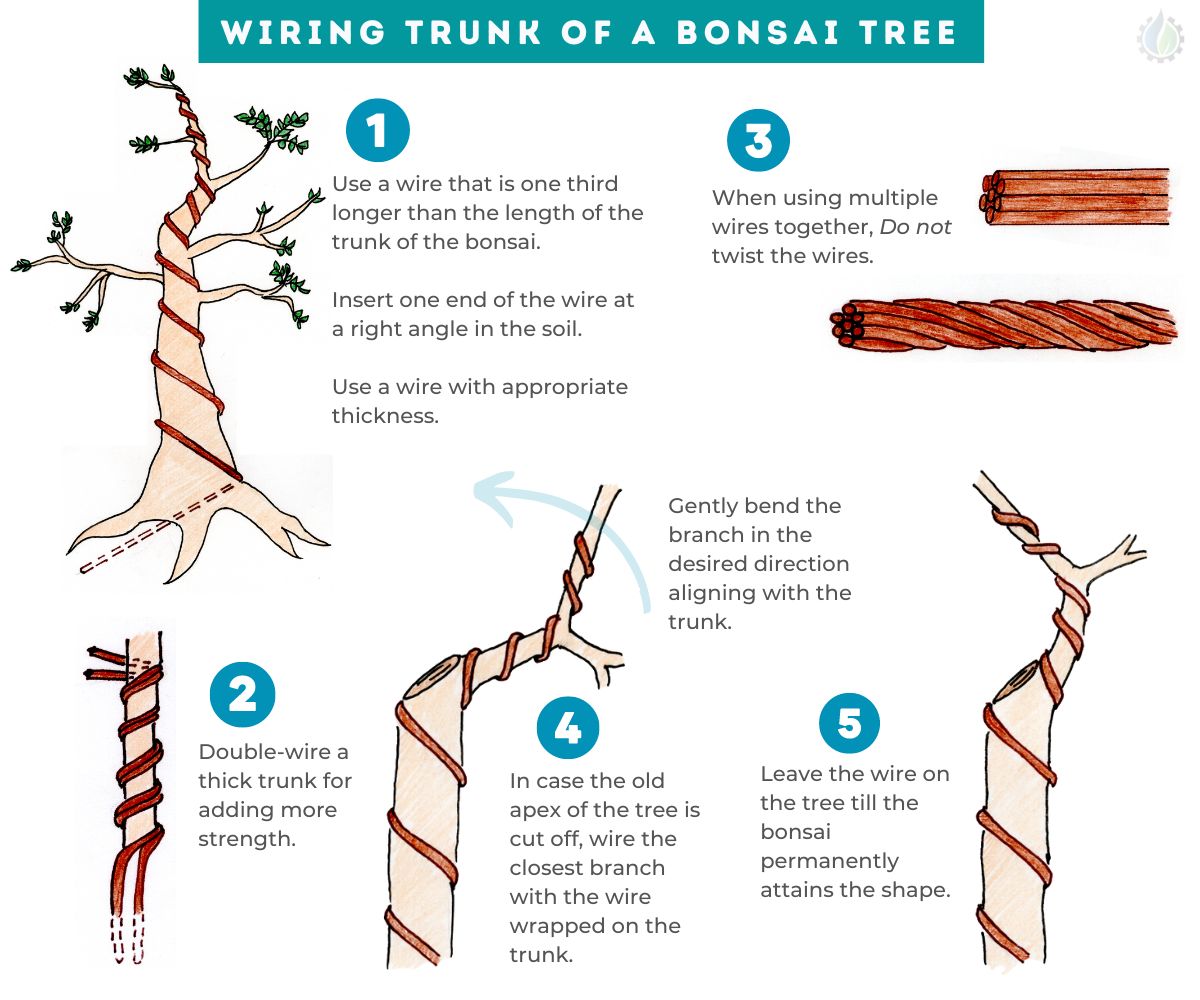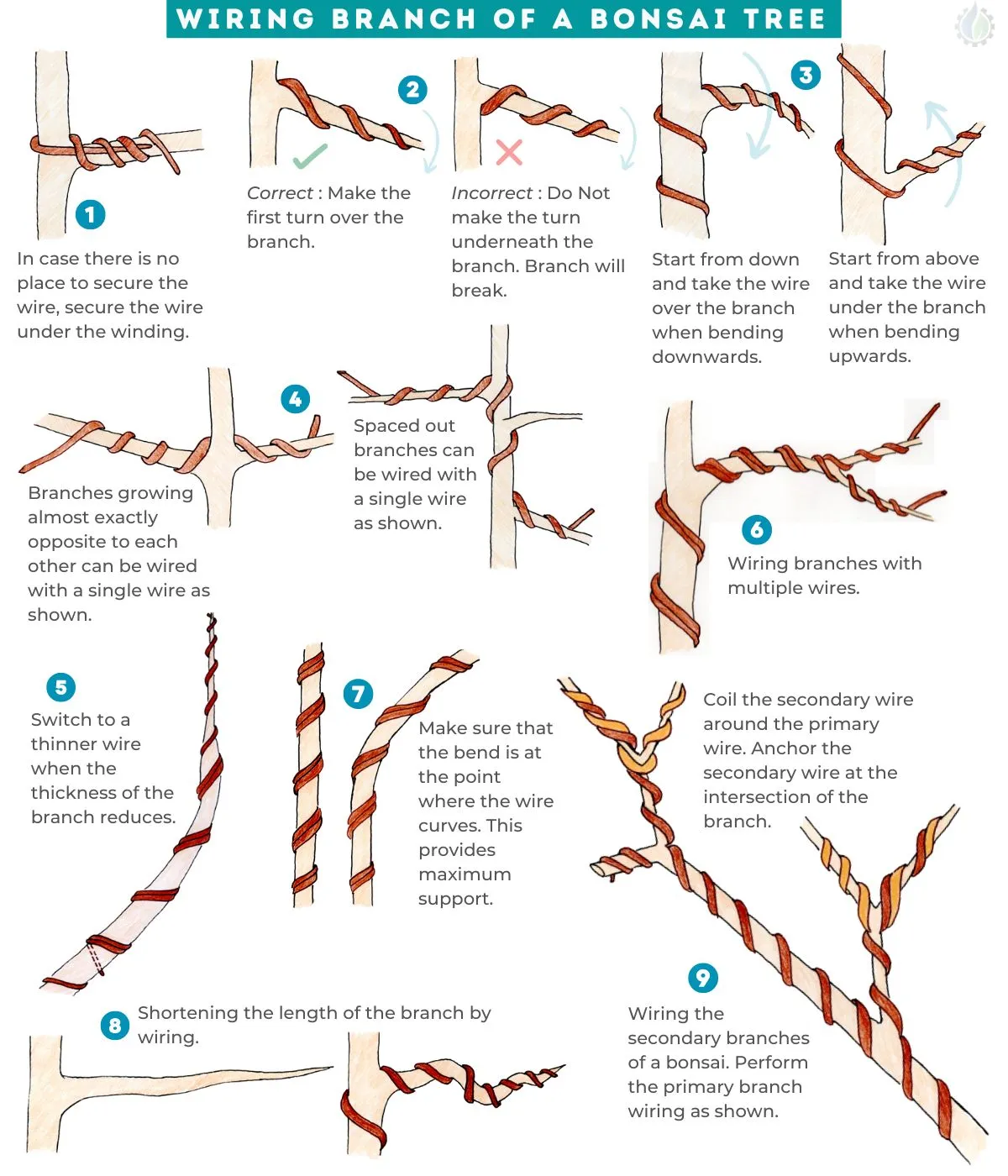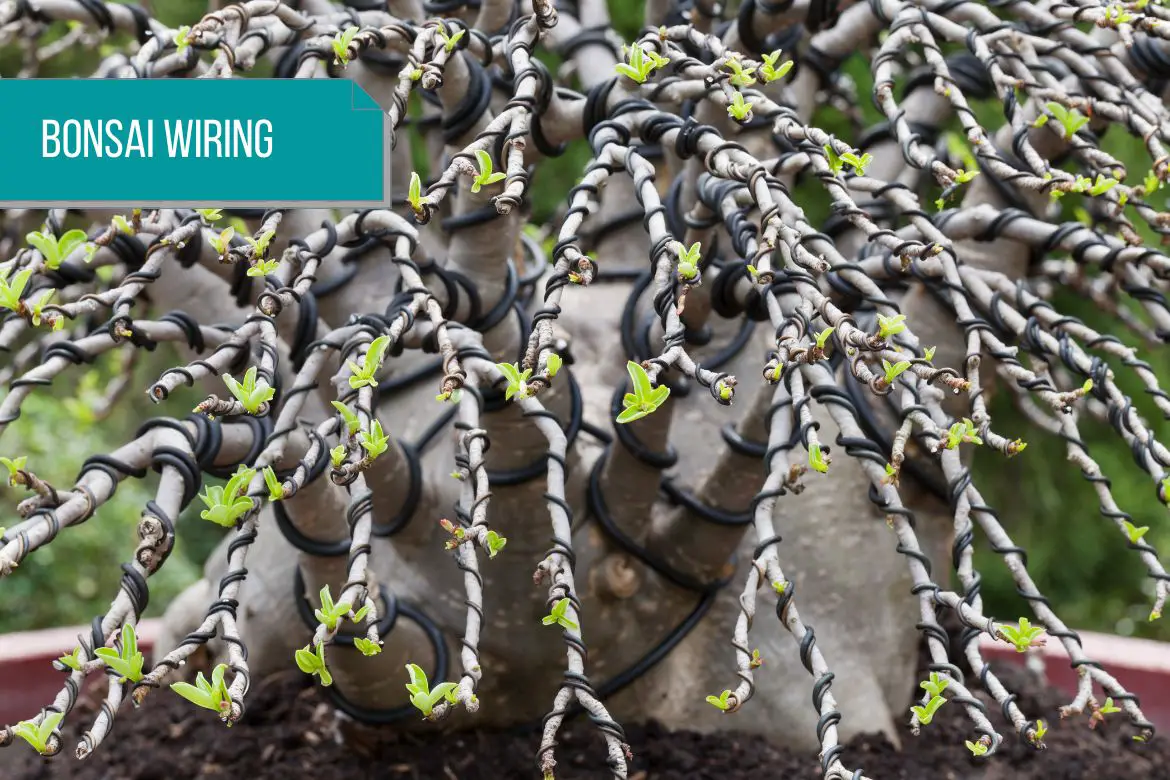In most cases, pruning a bonsai tree is adequate for achieving the desired bonsai style.
However, there will be times when something more will be desired as far as the shape of the bonsai tree is concerned.
Besides pruning, wiring is one of the most effective techniques for training bonsai. Next to pruning, wiring is the quickest way of styling bonsai trees.
Wire training bonsai is based on a simple principle. When a piece of wire of adequate thickness is wrapped around a branch, the two can be bent together and the wire will hold the branch in place.
Click and download the bonsai wiring techniques pdf. This PDF has all the infographics and illustrations mentioned in this article.
What kind of wire is used for bonsai?
There are two kinds of wires used for bonsai – Annealed copper wires & Aluminum wires. Aluminum wires also come in 2 colors – black and brown.
How thick is bonsai wire?
There are several different sizes of bonsai wire.
Annealed copper wires come in 8 different gauge sizes: #6 (4.12 mm / 0.16 inches), #8 (3.26 mm / 0.13 inches), #10 (2.58 mm / 0.1 inches), #12 (2.05 mm / 0.08 inches), #14 (1.62 mm / 0.06 inches), #16 (1.29mm / 0.05 inches), #18 (1.02mm / 0.04 inches), #20 (0.81mm / 0.03 inches).
Aluminum wires come in 11 different sizes: 1mm, 1.5mm, 2mm, 2.5mm, 3mm, 3.5mm, 4mm, 4.5mm, 5mm, 5.5mm, 6mm.
How to wire a bonsai tree?
There is no doubt that mastering the technique of wiring requires patience, but you also need a bit of skill and a certain amount of practice.
To practice wiring, a good idea is to choose plants that do not need any fundamental changes to their basic shape if you are a bonsai beginner. Also, there are very few things you will require to practice wire training (wires, pliers and wire cutter for beginners)-Check out all the bonsai tools you need to make a bonsai for more details.
Before moving on to bigger things, practice making small changes in direction on branches and twigs.
As you gain experience, you will be able to bend the whole tree. Getting the wiring right takes a lot of time, but once you achieve neatness and accuracy, speed will follow.
Some basic rules of DO’s and DONT’s of wiring are shown below:

(1) Evenly spaced wire with correct spacing
The angle at which wire is wrapped around a trunk or branch determines its capability to maintain its position. For a given wire thickness, a 45° angle provides the most strength. Also, maintaining the right spacing between each wire loop is important. This will come automatically as you gain more experience.
(2) Wire too loose
A loose wire will be ineffective in holding the branch or the trunk in the desired position. They will also damage the bark at the time of bending the branch.
You can, however, form a cage using wire within which a young/thin branch or twig can develop without being constricted.
(3) Unevenly spaced wire
Unevenly spaced wires are unsightly and is ineffective in holding the branch or the trunk in the desired position.
(4) Twisted wire
Twisted wires will be hard to bend, unsightly and also ineffective.
(5) Crossed wires
Two wires crossing over will stop sap flow, causing the branch to swell and eventually die.
(6) Wrapping multiple branches together
It is highly ineffective and can lead to breakage of smaller weaker branches.
(7) Trunk with textured bark
Do not wire a trunk which has got heavily textured thick bark. Trying to wire and bend this trunk will greatly damage the bark.
(8) Wire spaced too close
Wires wrapped too closely will restrict the flow of the sap in the plant. Eventually resulting in death of the branch.
(9) Wire spaced too wide
Wire spaced too wide will not have sufficient strength to hold the branch in the bent position.
(10) Wire too tight
A wire too tight will cut into the bark of the tree, permanently damaging the bonsai tree.
Tree tips and apexes should not be wired too tight because these areas grow much faster than the rest of the tree.
Wiring the main trunk of a bonsai
A trunk-wiring technique is usually applied to a young tree in order to direct its growth in the desired direction. In addition, it can be used to connect trees together when displaying them in a group bonsai style.

(1) Wiring the trunk of bonsai
When you begin with a tree that is young enough to have a flexible trunk, you will have the flexibility you need to introduce interesting shapes into the bonsai tree as it grows.
Choose a wire that is one-third longer than the length of the trunk of your bonsai. Also a wire with a suitable thickness.(generally, one-sixth or one-third of the diameter of the trunk)
Insert one end of the wire at a right angle (or even at a slight angle – the idea is to firmly secure that end of the wire) into the soil. While doing this, be careful not to damage too many roots.
Do this preferably on the side of the tree which is opposite the main viewing angle i.e. opposite the ‘front‘ of the bonsai.
Begin wrapping the wire in a counterclockwise direction. The first few wire turns will be almost horizontal. After those 1-2 turns, start wiring at a 45-degree angle.
Now proceed with wiring the trunk without moving the branches. (there is a situation where you will move to the branches, that will be discussed in the next coming points)
Also make sure to use a thinner wire as the thickness of the trunk decreases as you move up the bonsai.
As you are wiring, do not bend the tree as you go. Bending the tree should only start when the wiring is done.
Using your thumbs as fulcrums, bend the trunk with both hands.
(2) Double wiring the trunk
Sometimes thicker trunks will need to be double wired to provide additional strength to the wire. (also applies to thick branches)
Generally, these trunks cannot be wired with a single wire.
Once the first wire is placed, insert the second wire into the soil just like the first wire and start wiring the trunk aligning both wires together.
Make sure not to cross the wires.
(3) Using multiple wires together
There are times when multiple wires are used together. The reasons can be:
- Wiring a thicker branch or a trunk
- Splitting your wire from the main trunk/branch to other branches.
In any case, do not twist the wires together.
(4) Wiring a bonsai after shortening the trunk
There is also a practice of shortening the length of the trunk to achieve more ‘flow’ and ‘movement’ in the trunk.
This also introduces a taper to the trunk of the bonsai. However it should be noted that this will require a lot of patience from your end.
If you are planning to do this, make a cut as steep as possible (to achieve a smooth transition) on the trunk near a young branch.
Preferably make the cut opposite the ‘front’ view of the tree.
Now wire the trunk and the branch, and start bending the young branch upwards to form the new apex of the bonsai tree.
If the whole trunk is not wired then start on the trunk by winding the wire at least 3-4 times and then moving to the branch.
Repeating this process will give the trunk of your bonsai an interesting and distinctive appearance.
(5) Leaving the wire to achieve the desired shape
Leave the wire on the tree till the branch is permanently shaped. As time progresses, the changes you have made to the tree will be practically undetectable.
Wiring branches of a bonsai
Whenever wiring branches, it is critical not to use too much wire. This would not only look awful, but it would also restrict sap flow and could cause permanent damage to the branch. Furthermore, it may even be fatal.
Work out a strategy in advance. The trick to the art of bonsai is careful planning.

(1) Securing the bonsai wire on an isolated branch
By trapping the wire end under the first few turns, a branch that is too isolated can be wired.
(2) Correct way of wiring the branch for maximum support
When you bend the wire downwards, make your first turn of the wire over the branch. It is more likely for the branch to snap when bent if you make the first turn from underneath.
The same principle applies when the branch is being bent upwards. make the first turn of wire under the branch.
(3) Securing the wire on the trunk before wiring the branch
For the wire to be able to provide maximum support to the bent branch, a good rule to follow is to secure the wire to the trunk by making 3-4 turns.
And then apply the same principle of wiring mentioned in the point number 2.
(4) Wiring two branches with one wire
A single piece of wire can be used to wire two branches growing approximately opposite each other.
Make sure that the wire is looped correctly on the branch. Loop the wire from under the branch intersection, if bending downwards and loop the wire over the branch intersection when bending upwards.
Similar principles can also be applied when wiring two branches spaced apart with a single wire.
(5) Wiring a branch with varying thickness
When a branch tapers, you will need to use a smaller gauge wire. First wire the thinner wire along with the thicker wire for a few turns (3-4 turns should be sufficient). This will make sure the thin wire is secured and it firmly supports the taper of the branch.
The same principle applies to wiring the tapering of the bonsai trunk as well.
(6) Using multiple wires to wire multiple branches
Using multiple wiring technique is very easy to learn.
Time spent wiring can be significantly shortened by using the correct size wire and branching off as you reach each twig. However, multiple wiring is good for new material.
As mentioned earlier, do not twist the wires together.
(7) Bending the branch at the right place
When you make a bend on the branch after wiring, make sure that the out-most part of the curve should have the greatest support. Hence, keep the out-most curve at the place where the wire wraps the branch/trunk.
The space between the spirals wont be able to provide the maximum support to the bend.
(8) Shortening the length of bonsai branch using wire
You can either prune the branch of a bonsai to shorten it or you can wire the branch and shorten it by introducing multiple bends in it.
(9) Wiring the secondary branches of bonsai
Fine secondary branches can be wired with a thin wire to achieve a tighter formation.
Secure the wire by wringing it on a branch that is already wired. Anchor the wire to the nearest thick branch fork. Do not anchor the wire down to the primary branch as it will create congestion.
Start wiring up to the tip of the secondary branch. Repeat the process until you have wired all the intended secondary or tertiary branches and twigs.
Leave the unwanted branches for pruning.
Other bonsai training techniques

It is important to note that these techniques are inaccurate and will take a very long time to show results.
(1) Covering the wire
Cover the bonsai wire with raffia or paper to prevent the bark from scarring.
(2) The old way of using canes and rods
This is the technique that was used in the old days before modern branch/trunk bending tools were widely available.
This trick was generally used to make an elaborately twisted bonsai. Furthermore, this treatment is very effective on seedlings or tree species that have flexible trunks.
(3) Straighten a trunk using metal rod
Tying a metal rod to the trunk of the tree to shape it is also possible. Use wires or nylon strings to attach the rod to the tree and place rubber pads under the wire to prevent scarring to the bark of the tree.
(4) Bending the branch by tying it to the trunk
In most cases, a branch that is too stiff to bend by wiring can often be bent by tying it. Branches can be tied to the trunk using thin wires.
The branch should not be bent in position at once. Move it to 1/3 or 1/2 the final position. And then gradually move it further towards the final position after 2-3 months. Use the wire tightening method described in point number 8.
(5) Bonsai trunk shaping by anchoring the wire to the pot
It is also possible to shape trunks by tying one end of the wire to the trunk and anchoring the other end of the wire to the bonsai pot.
(6) Suspended wiring technique in bonsai
This important technique is also used for branches that are too strong to be wired and shaped.
One or several branches can be pulled down to give a weeping appearance. The wires can be tied to the bonsai pot.
You can also take a heavy gauge wire and run both ends through the drainage holes and under the base of the pot. Bring the ends above the soil and tie a loop at both ends.
The next step is to use thin wires to pull the branches down and secure them to the loops of the heavy gauge wire. Use rubber pads on the branches to avoid scarring.
(7) Using weights to bend branches of bonsai
You can also use weighted string or wire to hold the branch down. The weight should be carefully chosen; if the weight is too heavy, the branch will snap off. Special weights are available for this purpose. Weights such as stones and lead fishline can also be used.
The problem with this approach is that in order to achieve the desired result, it will take a long time. Furthermore, it is not as precise as wiring.
(8) Turnbuckle wiring in bonsai
Turnbuckle wiring refers to the process of using the strength of one section of the tree to change the direction of another section. This can be used to bring two branches together, two trunks together or pull a branch up or down by tying it to the trunk.
Make a loose loop around the branches and place a rubber pad under the wire to protect the bark of the tree.
Now put a piece of wood in the wire loop and rotate it so that it tightens the wire around the branches. This will result in the branches coming close to each other. Gradually tighten the wire over a few months.
Nowadays, special turnbuckles are available on the market that can be used for this purpose.

(9) Using metal rods for trunk’s shape correction
With the proper use of steel rods for tying and bracing, a bonsai grower will be able to correct the shape of the trunk of almost any tree with ease.
Can you bonsai without wire?
Yes. If you are happy with the ramification and the branch structure of your bonsai, there is no need to wire a bonsai. Wiring is only necessary if pruning the bonsai tree is not enough to achieve the desired ‘flow’ of the trunk and branches.
You can also bonsai a tree with special tools such as bonsai branch jack and bender or a piece of wood.

What size wire is best for bonsai?
On a bonsai, the size of the bonsai wire to be used depends on the size of the branch or trunk. Ideally, you should choose a wire whose thickness is approximately one-sixth to one-third the diameter of the trunk or branch.
Also, choose a wire that is one-third longer than the length of the branch or trunk being wired.
Why copper wire for bonsai?
Copper wires can be a bit tricky to work with in comparison to aluminum wires. If the copper wire is not annealed (softened) then the copper wire also needs to be heated first to make it pliable.
In spite of this, copper wire is still a popular choice among a lot of bonsai growers because it has the special advantage of being less visually disruptive than aluminum wires. Copper wire oxidizes quickly, becoming indistinguishable once it melds with the bark of a tree.
Copper wires are also stronger than aluminum. Which means that a relatively thinner copper wire can be used to bend a thick branch or trunk.
Copper wire is also best for conifer trees. (best supports soft textured bark)
The cons of copper wire can be that they are expensive and they can leave a heavy scar on the tree if not used properly.
There are also less obvious disadvantages such as that it rusts and forms verdigris, which can stain the trunk of the tree. Furthermore, it conducts heat and cold very well, so the cold air can be accentuated around the tree during the winter.
TIP : Copper wires should never be used on Prunus varieties (eg. Japanese flowering apricot bonsai), as they react badly to copper. Read bonsai tree care to know more about various bonsai tree species.
Can I use electrical wire for bonsai?
It is not advisable to use electrical wire on the bonsai tree.
Also, electrical wire that is covered in brightly colored plastic is distracting.
However, you can salvage the copper wire from the electrical wire. It can be annealed (softened) by heating it (until it is red hot) and then allowing it to cool slowly or you can immediately quench it in water for a few seconds to cool it down. Now, depending on the diameter of the copper wire, you can use it to wire bonsai.
Why aluminum wire for bonsai?
Aluminum wire in plain or anodized form is becoming increasingly popular (especially in the west).
Anodized or brown-colored aluminum wires are also inconspicuous when applied neatly. Black-colored wires are more visible on the tree.
Due to its softness, aluminum wire is the kindest to bark.
Aluminum wires are easy to bend and are also cheaper than copper wires. However, when bending heavy branches, thicker gauges of aluminum wire (or double wires) are necessary.
Aluminum wires can be used to wire both conifers and deciduous bonsai trees. However, many bonsai growers use copper wires for conifers and aluminum wires for deciduous trees.
Can I use iron wire for bonsai?
No. The rusting of the iron wire will cause staining on the tree.
The plastic-coated iron wire sold in garden nurseries for tying up climbers and so on, is far too rigid to be used for bonsai and should be avoided.
Furthermore, as the wire is wrapped around the branch, there is a tendency for the plastic coating to rupture. This causes the iron core to rust, which then causes stains on the bark or even corrosion as a result.
When should I start wiring my bonsai?
Even though you can wire at any time, some seasons are better than others.
For instance, wiring deciduous trees is easiest just before leaf buds emerge in spring or just before they become dormant in autumn.
It is best to wire leaf-cut trees like maples and elms as soon as the leaves have been removed.
You can wire evergreens at any time, however conifers are best wired late fall to early spring, when they are dormant.
Only after new shoots have matured, meaning they have hardened slightly (turned woody), they should be wired. During the main growing period, major changes to shape should not really be attempted.
However, the bark will be soft and sappy. So be careful while wiring.
You can refer to bonsai care guide to know more about the specific time a particular bonsai tree can be wired.
How long should wire be left on bonsai?
The amount of time for which the wire should be left on the bonsai tree depends on the bonsai tree variety its age, thickness and shape.
Branches that are young will be shaped quicker than old branches. Also, thin branches will set in position quicker than thick branches.
All things considered, if you are still trying to figure out the approximate amount of time it will take then note:
(a) Evergreens will take up to 9 months (sometimes longer) to get in shape.
(b) Deciduous trees will see good results in 3-6 months.
Springy conifer branches can take several years to set, while young deciduous shoots and twigs can set within a few weeks.
It is also worth mentioning that indoor bonsai trees require less time to adapt to new shapes than traditional outdoor bonsai trees.
Regularly check that the wires are not cutting into the bark after wiring a bonsai. (especially at the top of the tree where the growth is strongest)
After the branch/trunk has been firmly placed in its new position, remove the wire completely.
How to remove bonsai wire from the tree
You can unwind the wire, however cutting the wire into small pieces is best. Trying to unwind the wire increases the risk of damaging or tearing the bark. If you are unwinding, unwind the wire very carefully by retracing the direction of the wire.
It is always advisable to cut off the wires with a sharp wire cutter that can cut right to the tip of the blade.
After the wire is removed, some branches may slowly revert to their former positions. You can rewire these branches. However, if the bark is badly scarred, wire it in the opposite direction.
Can you reuse bonsai wire?
It may seem easier and certainly more economical to uncoil the wire and reuse it on the bonsai. But it is worth noting that unwinding the wire may tear the bark. Also, at the time of unwinding, the wire has a tendency to twist. And using a twisted wire for wiring bonsai is not advisable.
Hence, it is not usually recommended to reuse a bonsai wire.
Do bonsai wire scars heal?
The extent to which bonsai wire scars heal depends on the species of the tree.
For example, in the case of some varieties of maple trees with thin barks, wire scars will heal in a few years. However, a rough brown scar will still be visible on the tree. (especially visible on colored bark)
On the other hand, wire scar marks on the bark of pine trees are pretty much prominent and irreversible.
As you remove the wires and notice scars, apply some cut paste to the deep cuts. Hope for some good bark growth to hide the scars as much as possible.
In case you end up with scars on the bonsai, don’t stress too much about the scars on the branches that will be hidden because of the foliage pads.
In the event that a wire remains embedded in the tree despite all precautions, remove the portion that is not embedded with a wire cutter. Leave the rest in the bark. You can find a lot of beautiful bonsai trees out there that have a piece of wire embedded in them.

